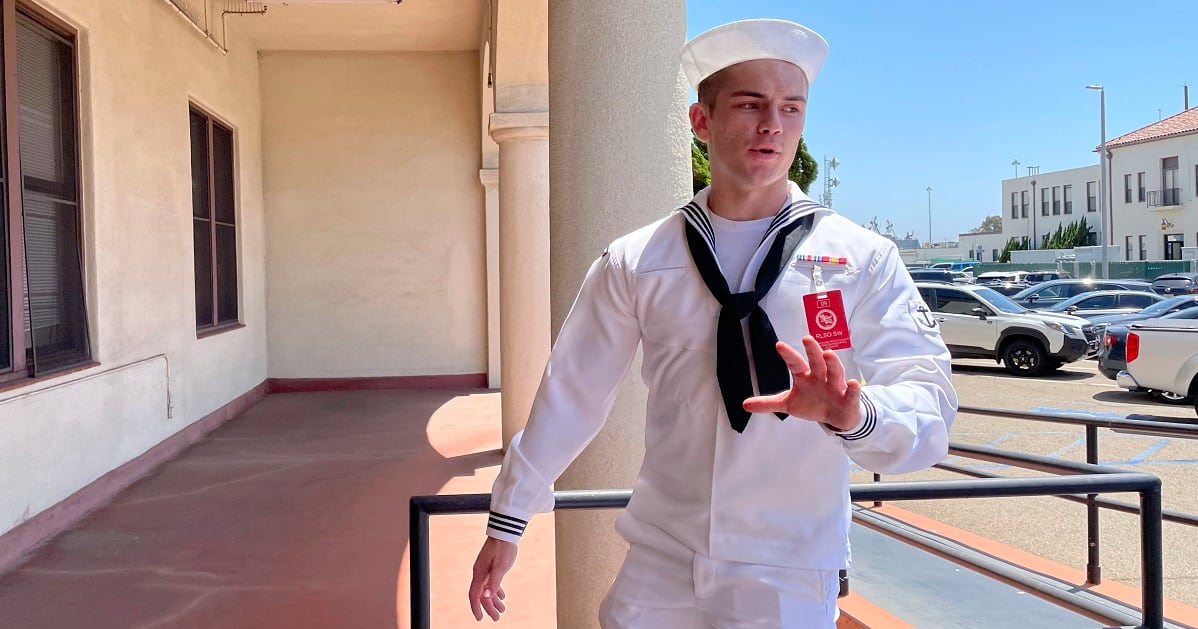This story was originally published by ProPublica, a nonprofit newsroom that investigates abuses of power. Sign up to receive their biggest stories as soon as they’re published.
On the morning of July 12, 2020, the first orange flickers of destruction took hold in the bowels of the hulking USS Bonhomme Richard as it sat moored at a San Diego naval base.
Unimpeded, the fire gathered force, surging upward, conquering one level of the 844-foot ship and then the next, while the crew — the ship’s critical firefighting force — fled to the pier. There, the captain and his sailors stood by as the Bonhomme Richard burned, in cruel irony of its motto “I have not yet begun to fight.”
Not until the San Diego fire department went aboard did anyone spray water on the fire — nearly two hours after it had started. By then it was too late. Gas cylinders were exploding and shooting through the air, and firefighters didn’t have a map or even a sailor to guide them through the smoky maze of the ship. A firefighter’s warning that a compartment was “about to blast” forced firefighters off the Bonhomme Richard just minutes before an explosion so powerful it was heard 13 miles away and hurled debris onto a nearby destroyer.
That afternoon, the flames, hot enough to warp steel beams, danced along the flight deck and engulfed the ship’s outer structure. As the inferno raged, it melted the inside of the 300-ton control center on top of the ship, spewing molten aluminum onto the decks below.
Before nightfall, the Bonhomme Richard was a salvage heap. Sailors later watched as the forward mast, where the American flag flies while the ship is at sea, collapsed.
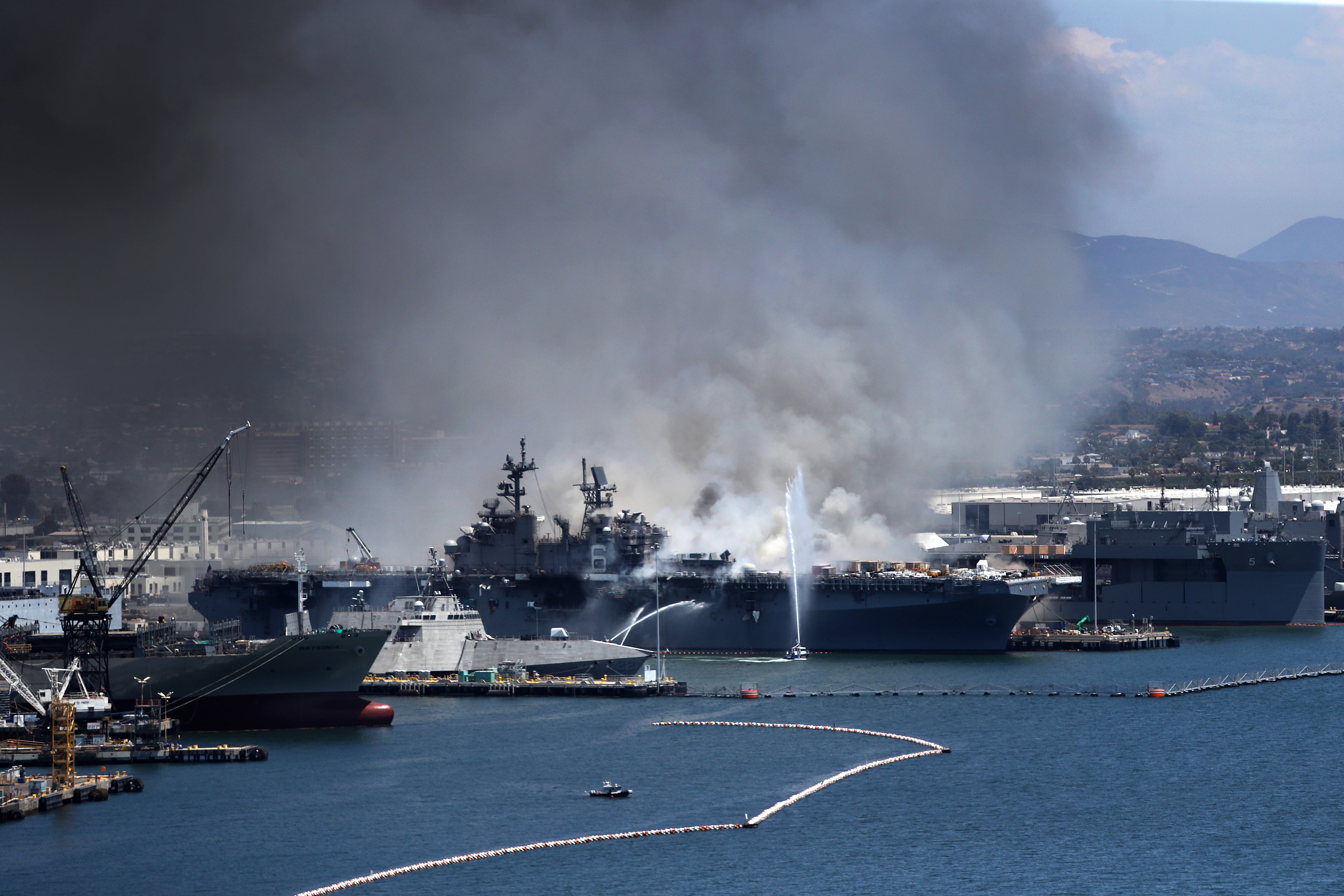
Four days later, when the fire was officially out, the U.S. Navy faced the sickening loss of a $1.2 billion-dollar warship, not to war, or even at sea. But to a wholly preventable fire while moored in a stateside port. For the Navy, whose reputation as the world’s finest had been battered by recent collisions at sea and allegations of shoddy equipment and training, the loss of the Bonhomme Richard was an embarrassing — and painfully public — blow.
The service immediately launched two parallel investigations into what went wrong and why.
The command investigation, led by a three-star admiral, sent a team of investigators on a prodigious and methodical examination of the fire. As the months passed, the investigators uncovered in exhaustive detail an astonishing array of failures — broken or missing fire hoses, poorly trained sailors, improperly stored hazardous material — that had primed the ship for a calamitous fire.
A separate investigation by the Naval Criminal Investigative Service, for its part, focused on whether anyone was criminally responsible. As the months passed, NCIS investigators appeared to operate in isolation, discounting the damning findings of the command investigation to pursue a case of arson, despite scant evidence.
Six weeks into both inquiries, the Navy told the command investigation to accept at face value what NCIS and federal fire investigators judged to be the fire’s origin. Both investigations concluded in 2021.
The command investigation traced the problems back to when the Bonhomme Richard docked for maintenance and Navy leaders throughout the ranks abandoned responsibility for the ship’s safety. Risks mounted, and nobody paid attention. All told, investigators determined that the actions of 17 sailors and officers directly led to the loss of the ship, and those of 17 more, including five admirals, contributed. The long list was a staggering indictment of everyone from sailors to top admirals who had failed in their jobs.
The NCIS investigation, however, laid the blame at the feet of a single young sailor. The true culprit, the one who bore responsibility for the billion-dollar loss, the Navy said, was then-20-year-old Ryan Mays. And for that, he should face life in prison.
The Navy continued its pursuit of Mays, even as a military judge recommended against it, bluntly calling out the lack of evidence and citing the findings of the Navy’s own command investigation.
Starting Monday, Sept. 19, 2022, Mays is being court-martialed in a military trial in San Diego for aggravated arson and willfully hazarding a vessel.
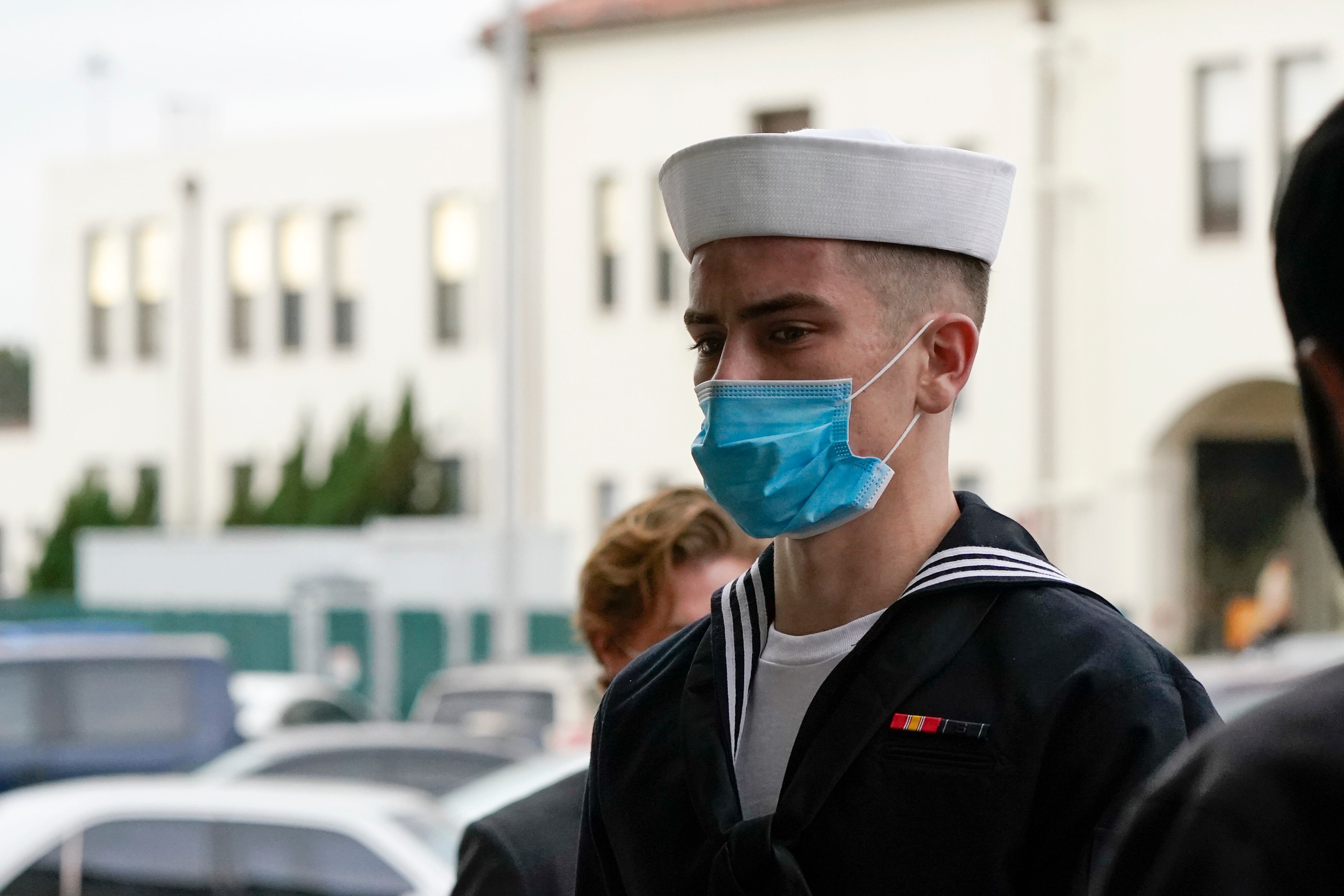
A Navy spokesperson said the service couldn’t comment on ongoing litigation, but noted that the admiral who ordered the court-martial carefully reviewed the recommendation before deciding to move forward. “Everyone is entitled to a fair trial and the Navy is committed to upholding that principle,” Cmdr. Sean Robertson said.
In court, the Navy has tried to stymie questions about its motivations — and even to quash evidence its own officers gathered about dangerous conditions aboard the Bonhomme Richard. Last month, the prosecutor, Capt. Jason Jones, asked the judge to forbid Mays’ counsel from presenting the conclusions of the command investigation. Mays, who now holds the lowest military rank of E1, should not be able to ask the court to view him as the fall guy, Jones said.
The Navy wasn’t the problem, Jones said in court, and the trial argument shouldn’t in any way imply that “the Navy needs a scapegoat and therefore we picked an E1.”
On Naval Base San Diego’s Pier 2, investigators cordoned off the charred wreckage of the Bonhomme Richard with yellow police tape.
Within days of the fire being extinguished, Bureau of Alcohol, Tobacco, Firearms and Explosives investigators, who co-led the criminal inquiry with NCIS, stepped into the watery shell of the ship, looking for what ignited the blaze.
Because the amphibious assault ship had been “in the yards” at the time of the fire, its flight deck, which stretched longer than two football fields, had been empty of the helicopters and F-35 fighter jets it was designed to carry. One of eight such ships in the Navy, the Bonhomme Richard is like a small aircraft carrier, made to ferry thousands of Marines into combat. It had been out of commission for a year and half during a $249 million overhaul. The morning of the fire, the upgrade was nearly complete.
The agents determined that the fire had started in an area of the ship known as the “lower V,” which normally stowed dozens of Marine Corps tanks and other vehicles, but during the overhaul was being used as a catchall, according to testimony and reports. On the day of the fire, the lower V had been packed with two fueled forklifts, a man lift, pallets of hand sanitizer, lithium batteries and other combustibles, wood beams, scaffolding, rope and thick, tall cardboard crates, some stacked two high.
A warship is an unusual scene for ATF investigators. They turned to the ship’s damage control assistant, Lt. Cmdr. Felix Perez, for a tour. Perez was the officer directly in charge of the firefighting hoses and systems aboard the ships, training sailors to fight fires and ensuring the ship followed fire prevention precautions.
Perez guided the agents through the ship, stopping at the fire stations closest to where the fire began. At three, hoses were missing, cut or otherwise unusable. Perez told the agents he or his staff had walked the ship two days before the fire, and it was nearly impossible they had overlooked the fire stations, according to an NCIS affidavit about the case.
The stations, Perez told the agents, must have been tampered with.
Military officers salute in the direction of a burning ship. Nearby, a large pile of gas cylinders rests on a lawn.
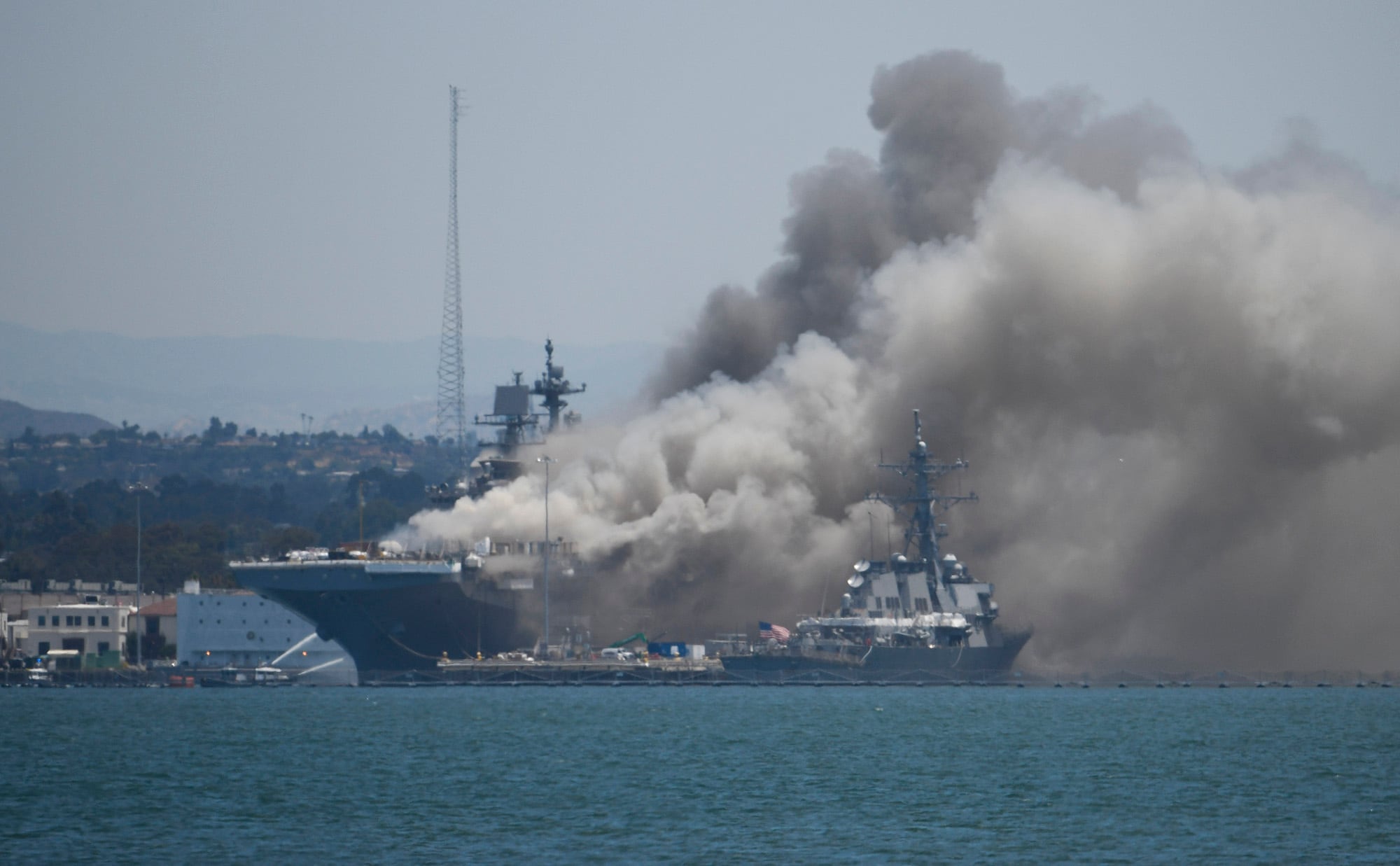
A few weeks later, in a building catty-corner from the Bonhomme Richard, some 77 naval officers, enlisted experts and civilians set up shop for the command investigation.
Early on, investigators realized Perez had not done his job well, according to a person close to the investigation who spoke to ProPublica on the condition their name wouldn’t be used so they could speak freely about sensitive matters. The fire stations were inoperable from broad neglect — and Perez and other leaders had failed to recognize the disintegration of the ship’s condition.
From the start of the command investigation, NCIS immediately curtailed the team’s efforts, forbidding its experts and officers from interviewing anybody from the ship, command investigators wrote in their report. Backed by Navy policy, NCIS’ criminal inquiry took precedence over the systemic investigation. So the command investigators turned instead to 26,000 pages of records, downloading databases and piecing together logs of the ship’s equipment, maintenance and training.
The investigators soon discovered an astonishing list of ways the ship was at risk, so many that cataloging the bad decisions day after day became depressing, the person involved said. For long stretches, all the ship’s heat sensors, sprinklers and other emergency systems were turned off, investigators wrote in their report. On the day of the fire, just 29 of the ship’s 216 fire stations and 15 of 807 portable fire extinguishers were in standard working order.
Perez was the ship’s principal representative on its mandated fire safety council, which investigators found met ad hoc and seemed to exist simply to waive safety requirements. Investigators scoured the meeting minutes and logs looking for ways Perez and others had considered mitigating each risk created by waiving those requirements and found almost none. They concluded that Perez, as well as his direct boss and other senior leaders, had abdicated their responsibilities for addressing fire prevention on the ship. Perez declined to comment on the investigation’s findings but said he thought his naval record showed he was a good officer.
Investigators also learned that Bonhomme Richard sailors had been living nearby on a berthing barge, basically a floating dormitory, until shortly before the fire. But that week they’d started to move back onto the ship while it was still in disarray. The supplies of both the contractor and the ship were shoved everywhere. The disorder had become normalized enough, the investigation found, that sailors of all ranks routinely walked by improperly stored oil drums, gas cylinders and other combustible items without much thought to the danger. To investigators, the condition of the ship was an “ideal environment for the fire to develop and spread.”
Just days before the fire, Mays had angrily texted his division officer, complaining about having to live among contractors who were doing work that was “hazardous as fuck.” A worker was welding near his bunk as he slept, and Mays said he was burned by a stray spark. In 2015, a major fire started on another warship in a shipyard with similar conditions: sailors moving aboard while “hot work” was being done.
The command investigators hung posters of ship drawings all over the walls, each one tracking a different potential problem. While NCIS’ early impressions of the case included a theory of sabotage, another picture altogether was becoming clear to command investigators: The Bonhomme Richard had been a tinderbox.
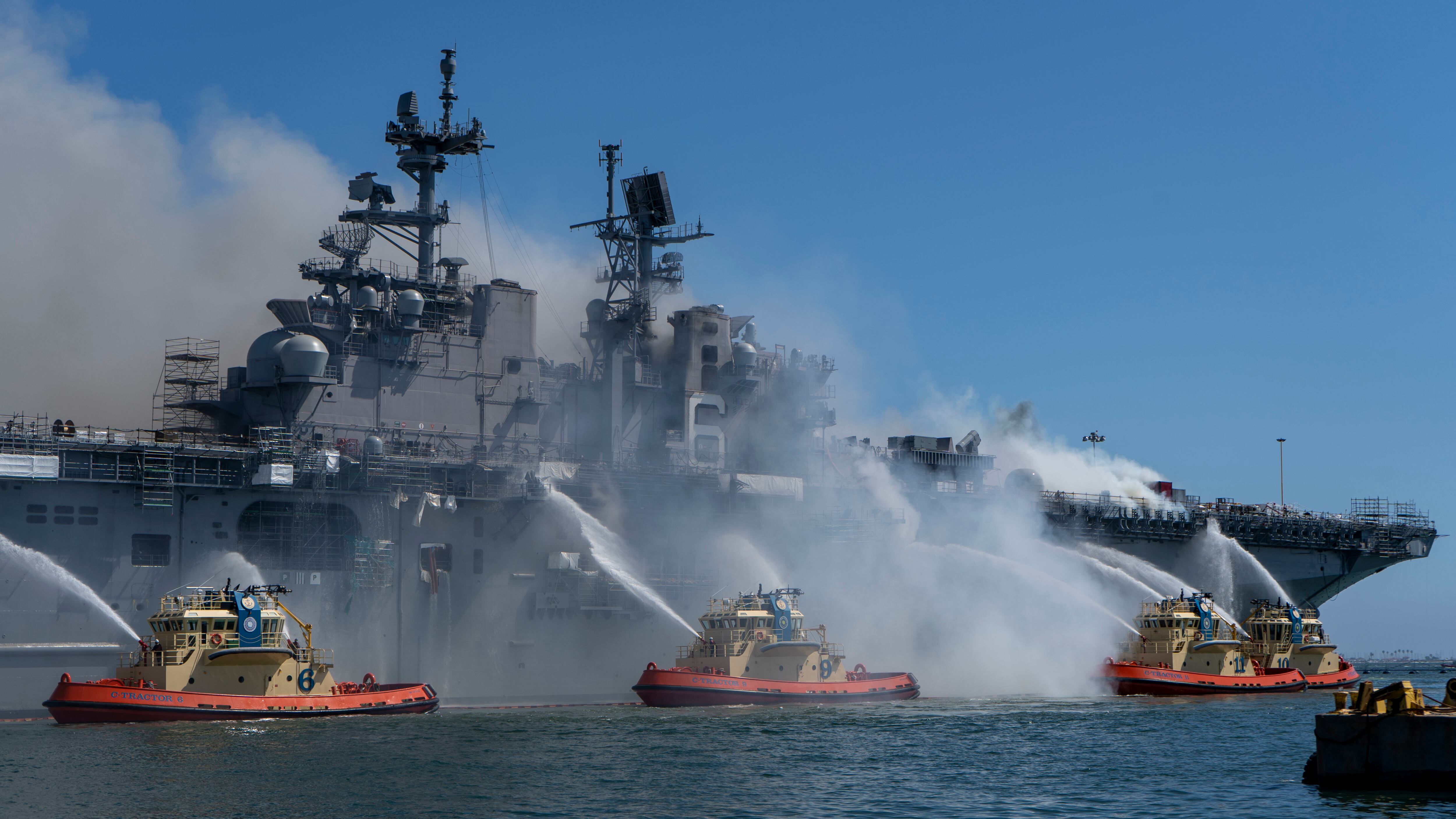
On July 24, 2020, less than one week after beginning the criminal investigation, the ATF preliminarily ruled the Bonhomme Richard fire to be arson.
The lead ATF agent, Matthew Beals, and his team of investigators had found no physical evidence anyone purposefully set the fire. Beals later testified that he’d ruled out accidental causes, such as electrical and mechanical, as well as natural ones. With those causes eliminated, along with his assessment of how the fire grew and witnesses’ statements, he concluded it must have been arson.
The National Fire Protection Association’s 921 guide, essentially the fire investigation bible, requires investigators to use the scientific method to determine cause. “You can’t in the absence of everything else rule it was arson,” Robert Duval, a director with the association, told ProPublica. ATF said it could not comment on pending litigation. Beals testified that his methods followed the manual and his conclusions were based on a variety of evidence.
In the area of the lower V that was most heavily scorched by the fire, Beals focused on the large cardboard crates he’d later call “Amazon boxes on steroids.” He theorized based on field tests that someone used an accelerant to ignite them, but said in court that he couldn’t find any fire data to corroborate.
He would testify at Mays’ probable cause hearing that he believed the fire was started by someone purposefully using an open flame and possibly an accelerant on the boxes.
NCIS began interviewing Bonhomme Richard sailors. Earlier in the year, NCIS publicly acknowledged the field office in San Diego had mishandled a high-profile investigation into Navy SEAL Special Operations Chief Edward Gallagher for war crimes; Gallagher was acquitted. The Navy took corrective action against seven agents. As the NCIS office developed its case on the fire, its leadership was still under a cloud.
The Bonhomme Richard’s top enlisted sailor identified Mays as someone who disdained the Navy, according to an NCIS affidavit. To go with their finding of arson, agents had a name of a possible suspect.
Mays, just out of high school and still baby faced, was known as something of a loudmouth on the ship. He’d enlisted early in Kentucky with his mother’s permission as a 17-year-old senior who liked science, swimming and running across the football field shirtless with the flag before Friday night games. His Navy contract guaranteed him a chance at BUD/S, the notoriously grueling training program for the SEALs.
Mays appreciated the camaraderie of orientation, but wasn’t mature enough to last when training got intense. He quit on the fifth day. That left him without a Navy career path, and he was in limbo for months afterwards, awaiting a new assignment.
Mays stole a pair of headphones from the base store, thinking naively that it would be “a fast track out of the military,” he told ProPublica. To his surprise, he was only reprimanded, and the commander encouraged him to embrace his potential and his time in the Navy.
Mays said that restoked his desire to become a SEAL. The Navy gave sailors three chances. When he was sent to the Bonhomme Richard in March 2020, Mays was single-minded. He could stand on the flight deck and, on a clear day, see across San Diego Bay to the Coronado beaches where the SEALs train. That was where he wanted to be. Or at least in a special warfare program, like explosive ordnance disposal.
He buddied up with another sailor with similar goals, and they tested their physical limits with overnight workouts. Mays was small but strong and his ego surfaced in the usual teenage way: social media preening. Around the ship, he earned eyerolls from fellow sailors when boasting that he belonged among elite sailors. Mays was in reality a low-ranking deck sailor, mopping, painting and carrying out other menial custodial duties aboard the Bonhomme Richard.
Records and interviews showed agents zeroed in on Mays’ discontent and the fact that he dropped out of SEAL training.
Command investigators, meanwhile, were finding that the basic principle of firefighting as survival had withered during the Bonhomme Richard’s extensive time in port. Just as every Marine is a rifleman, every sailor is a firefighter. No matter what a sailor’s job is, knowing how to contain and extinguish a fire is paramount. When a ship is at sea, there’s nowhere to escape.
The investigative team broke into smaller groups to examine what should have happened during the fire and what actually did.
Shortly after 8 a.m., sailors first reported spotting smoke. Investigators were dumbfounded at the lack of urgency after that. Navy policy, they wrote in their report, dictates that sailors must douse flames with water as soon as possible but at most within 12 minutes. On the ship that day, more than 10 minutes elapsed before anyone even announced the fire over the ship’s loudspeaker. The slow response, they found, was typical for the Bonhomme Richard. For 14 drills in a row leading up to the fire, the crew failed to respond in time — a lack of proficiency that neither the ship’s leadership nor higher commands took steps to address.
That critical gap between the sign of smoke and the sounding of the alarm, investigators found, was the first in a cascading set of failures, by both the crew and leadership on the pier. Once the sailors realized many of the hoses nearest the fire weren’t operable, investigators learned, none of them moved to another important shipboard strategy to contain the fire: slamming shut the heavy steel hatches and watertight doors between compartments. And the sailors revealed that at first no one thought to use the ship’s sprinklers to distribute thick, white foam that can help extinguish the fire. Even if they had, they would have been unable to easily turn on the system: A maintenance report had been falsified in April, saying the system worked when it didn’t.
As the command investigation took a wide view of what led up to the fire, NCIS, records show, sharpened its focus on Mays. On the morning of the fire, Seaman Kenji Velasco, who had just come on duty along with Mays, had been standing watch at the top of the ramp to the lower V. He told NCIS that he saw someone go down the ramp shortly before the fire.
Velasco told nobody about this person for days, according to testimony — not even during the fire, when that person could have been in danger of being killed. When Velasco sat down with agents, he told them that someone had walked behind him, “but I’ve never seen him before.”
Agents went back to Velasco the day after the interview. This time Velasco said he was “fairly sure” the person was Mays, according to NCIS documents. Velasco told the agents that Mays was cocky and talked too much.
The agents then brought Velasco back again: How certain was he that he saw Mays? “90%,” Velasco told them.
The next month, agents scooped up Mays, surprising him as he checked in for work. The ATF’s Beals and an NCIS agent questioned Mays in a recorded interview for nearly 10 hours. He told them more than 150 times that he didn’t set the ship on fire.
The morning of the fire, Mays should have had a broom and dustpan in his hand, cleaning the back of the ship. Mays told agents he was instead just hanging out there, scrolling through his phone. With 24 hours of duty and not much to do, he wasn’t in a hurry right after roll call, and besides, he told ProPublica later, the general culture of the ship on its second extension in the yards was lackadaisical.
On a recording of the interview, Mays, wearing a brown uniform T-shirt and occasionally sweeping his hair off his forehead, vacillated between confrontation and distress.
In a confident voice, he asked eight times in two minutes if he was being detained.
“I’m not answering your questions, Ryan,” Beals said.
During his interview, Mays crudely put on display his disregard for the fleet Navy, and spoke of his desire to be a SEAL. In the beginning he even asked NCIS agent Albert Porter, a former SEAL, for a recommendation. Porter told Mays he’d never have another shot at the training program: “You’re not going back, dude. It’s not happening.”
Beals pressed him to “just admit to what you’ve done.” At one point, he told Mays they had him on video.
“You’re a liar,” Mays said.
“You’re a liar,” Beals replied.
Several times throughout the day, Mays asked to call his mom. He tried to think of anything he could tell the agents that would show them he was innocent. He begged them to take his DNA, search his phone and use GPS to track his whereabouts at the time.
At one point when the agents left him alone, he exclaimed to the empty room: “I didn’t do it. Let me go.”
Then he laid his head on the table and sobbed.
When Mays learned close to midnight he was going to the brig, a sailor who had been preparing to transport him said she heard Mays say something like “I’m guilty. I did it, I guess,” according to records and testimony.
Agents took the alleged remark as a confession. Mays said he was being sarcastic, expressing disbelief he was being arrested for a crime he didn’t commit.
The Navy booked Mays into the brig on Aug. 20, 2020.
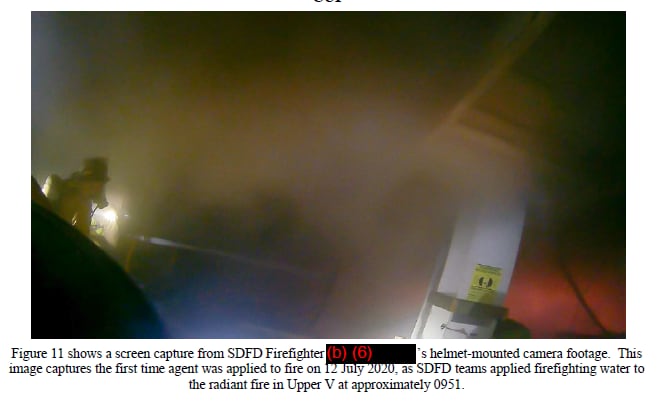
In the months after the fire, NCIS and ATF agents were slow to interview some of the sailors who had been aboard the ship during the fire, NCIS records of interviews show. One of those sailors was among the first to see smoke that morning.
About a month after Mays was arrested, the witness told agents she had seen a sailor sprinting from the lower V about the time she saw a “white fog” wafting up. She identified the sailor as Seaman Recruit Elijah McGovern.
A month and a half later, records show, NCIS and ATF agents asked McGovern where he was when the fire started. McGovern denied setting the fire. He gave a series of stories over several interviews about where he was at the time that were later contradicted, witnesses testified. ProPublica could not reach McGovern for comment.
Beals and NCIS agent Maya Kamat investigated McGovern for months but ultimately set a low bar to clear him. They found grainy, distant video of a base exit near the Bonhomme Richard that showed a person leaving about 25 minutes after the fire started. Beals and Kamat testified they could not identify McGovern’s face on the video. But Beals said he could tell by the person’s “gait and walk and general build” that it was McGovern. Kamat said she thought the nondescript clothes matched McGovern’s. The agents decided the video helped provide McGovern an alibi, they testified at a preliminary hearing. NCIS said it could not comment on pending litigation.
The Navy was also quick to dump its own expert. After Mays was arrested, someone scrawled on a port-a-potty near the ship, “I did it. I set the ship on fire,” among other things, including a crude drawing of the ship in flames. The military’s handwriting examiner said he matched the script to McGovern’s.
Handwriting analysis is controversial, but the government often presents it as trustworthy evidence. Here, though, the graffiti didn’t identify the sailor the Navy ended up accusing of the crime, so prosecutors wanted it excluded from Mays’ court-martial, arguing at a preliminary hearing it was not strongly conclusive and irrelevant.
McGovern was kicked out of the Navy for misconduct the week of his last interview with investigators, records show.
After the Navy lost a submarine, the USS Miami, to a fire in a Maine shipyard in 2012, the service adopted a “never again” mentality and issued a new 129-page fire safety manual. Command investigators concluded it was merely a paper fix. Three major fires in shipyards after the Miami had similar troubling patterns. And investigators found that some admirals in charge of maintenance weren’t following the manual.
NCIS had kept investigators from interviewing 150 Bonhomme Richard crew members and others until the first week of December, five months after the fire, according to the command report. By the time investigators could sit down with the ship’s leadership, they had already pieced together the ship’s poor condition. As officers came in one by one, investigators were surprised to find out how little they knew about the state of their own ship.
Capt. Gregory Thoroman, the Bonhomme Richard captain, broke down several times throughout the interview. As a Navy pilot put in charge of a large ship, he was somewhat out of his depth of expertise. For example, Perez hadn’t always told the captain about the safety requirements he was waiving, investigators wrote, and Thoroman didn’t know enough to ask.
The Navy’s backstop system for when an aviator such as Thoromon is in charge is to require the No. 2 be a surface warfare officer. That also failed: Capt. D. Michael Ray, investigators learned, wasn’t paying attention either.
Investigators were startled to find that even though the ship had recently loaded 900,000 gallons of fuel, none of the ship’s leadership knew which emergency response systems were working. Thoroman hadn’t read the fire safety manual, investigators found. Ray and other key officers on the ship, including Perez, didn’t understand it. Neither Thoroman nor Ray responded to requests for comment.
Command investigators also found that the admirals charged with overseeing ships in maintenance hadn’t noticed the rising risks on the Bonhomme Richard. Other admirals and captains responsible for fire response didn’t ensure even foundational precautions, such as having large fire pipes on the piers and the distribution of ship maps to local fire departments.
The Navy was at risk for mishandling even a minor fire, investigators found.
A year after the fire, as top Navy leadership was endorsing the command investigation findings, the service was also charging Mays.
To some, the Navy’s actions were reminiscent of an ugly piece of its history. In 1989 an explosion on a turret of the USS Iowa killed 47 sailors, and the Navy tried to pin it on one of the dead sailors, who leaders suspected was gay. Only after Congress stepped in did the Navy acknowledge there was no evidence for its assertions.
More recently, after back-to-back collisions in the Pacific in 2017, ProPublica exposed how the Navy downplayed systemic culpability and fired those who had raised alarms.
After a dayslong probable cause hearing for Mays in December 2021, the judge said she wasn’t persuaded of Mays’ guilt. A nuclear-trained surface warfare officer who later became a Navy lawyer and then judge, Capt. Angela Tang is known for being thorough.
“Given the state of the evidence presented to me, I do not believe there is a reasonable likelihood of conviction at trial. Therefore I do not recommend referral of these charges even though there is probable cause to support them,” Tang wrote in her findings.
ProPublica reviewed the conclusions of her 43-page report, which the Navy has withheld from the public, as it has with almost all other court records in the case. Probable cause is a low bar, Tang cautioned. In explaining her recommendation to drop the charges against Mays, she repeatedly refers to “if” the fire was arson.
Her report also notes that defense expert witnesses testified about finding two other possible causes: lithium batteries that had leaked and exploded and arcing from an engine wire on a forklift. Given that evidence, the experts testified, the only reasonable conclusion was “undetermined.”
None of the evidence proved the fire was deliberately set, Tang wrote, and ATF’s conclusion could be doubted because agents missed possible causes found by the defense in the four hours they had at the scene. Tang noted Velasco was the prosecution’s lone eyewitness and — even if believable — wasn’t enough to hang the case on. She wrote that Velasco’s credibility was undercut by how long he took to report seeing someone and by his inconsistent statements, as well as by other witnesses who contradicted what Velasco said Mays was wearing. Furthermore, even if Mays was seen, it did not prove he set the fire or that it was arson, she wrote.
She also said investigators had valid reasons to suspect McGovern and wrote that jurors would probably view Mays’ “I’m guilty” remark as sarcastic.
Tang referenced, too, the Navy’s own conclusions that if not for systemic failures, the fire would have been extinguished long before the ship was lost. The Navy charged Mays with hazarding a vessel, but Tang wrote the fire, if arson, seemed intended to cause a distraction, not destroy the ship.
Vice Adm. Stephen T. Koehler, the military commander with the final say about whether to prosecute Mays, disregarded Tang’s recommendation. In February, the Navy announced Koelher had decided to send Mays to court-martial.
Much of the Navy’s case against Mays hinges on his alleged motive. Prosecutors are claiming he was a disgruntled sailor who hated the Navy so much he torched the ship out of revenge.
The Navy believes Mays was consumed by the realization he’d never don the SEAL trident, and having to move to a new berthing aboard the ship “sent him over the edge,” one of the prosecutors, Lt. Cmdr. Shannon Gearhart, said at a preliminary hearing.
Mays’ civilian lawyer at the time, Gary Barthel, argued at the probable cause hearing that Mays’ hubris proved he was an unlikable braggart but not an arsonist.
The young sailor was also making efforts to reapply to SEAL training, both through his punishing workouts and by asking for recommendations and taking steps to earn special qualifications to bolster his application, such as search and rescue swimming, according to Mays and his lawyers. His mom, Christy Hall, told ProPublica that her often-stubborn son “was bound and determined to go back” to the training program. He’d only had one strike, and had two more tries, she said he told her.
Two years into the ordeal, at a hilltop park overlooking San Diego, Mays sat with a military bearing, speaking with a newly reflective self-awareness. He said it’s fair for the Navy to say he had a bad attitude and didn’t want to be on the Bonhomme Richard.
“I don’t know how I feel about the word ‘disgruntled’ that they’re using right now. That doesn’t really make a lot of sense to me,” he said. “I was just like every other sailor in the department that didn’t appreciate, you know, cleaning shit. And so I don’t know if that makes me disgruntled or not.”
When Tang recommended against a court-martial, Mays said, he briefly felt relief. He thought that the anxiety that had him throwing up nearly every morning would finally subside. Then the Navy announced it would still prosecute him.
The experience, especially his time in the brig, has been “soul crushing,” he said. “A piece of me died in there and I don’t know if I’ll ever get it back.”
The Navy decommissioned the Bonhomme Richard after estimating it would have cost $3 billion and at least five years to fix. The service said that it made changes to its fire prevention policies, including instituting random safety checks and clarifying the chain of command. More than 20 people, including three admirals, were disciplined. The captain, executive officer and top enlisted officer on the ship all received punitive letters of reprimand, which is typically a career ender.
Mays’ defense has noted that on the same day as the Bonhomme Richard fire, another big deck ship at the San Diego base caught fire. NCIS concluded the USS Essex fire was arson, but that blaze was extinguished before it caused any damage. In this case, like Mays’, there was a single eyewitness who identified someone at the scene shortly before the fire was discovered. But the case was closed without charges after a yearlong investigation. The agent in charge testified that the suspect was “ultimately eliminated because nothing more linked him to the fire aboard the Essex.”
One of Mays’ defense attorneys pointed out at a preliminary hearing that “the Essex facts are eerily similar.” Except that ship didn’t burn down, so the investigation “just went away,” Lt. Pete Link said.
In the Bonhomme Richard case, there was a costly loss of an entire vessel, Link said, “and now here we are in court.”
Megan Rose is a reporter at ProPublica. She has investigated criminal justice and the military for ProPublica since 2013.
